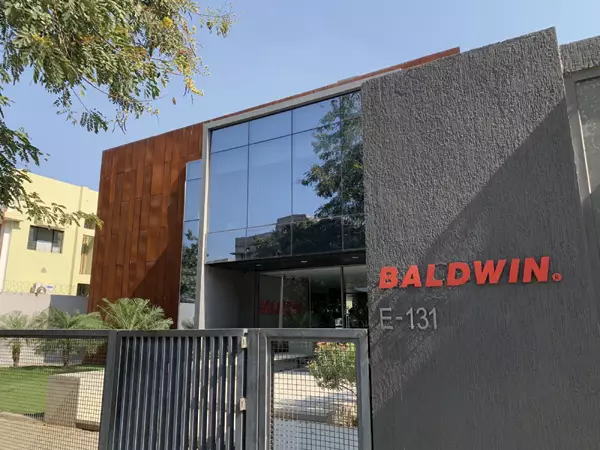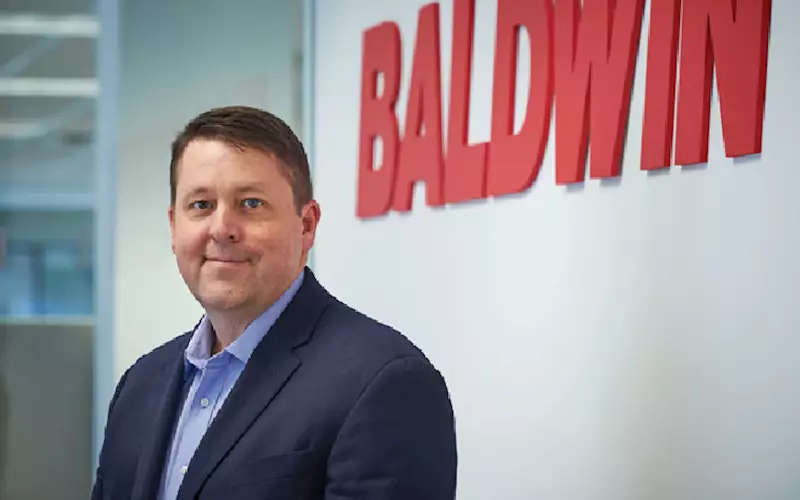Joe Kline: Never been more important than now to focus on packaging and labels
Baldwin Technology CEO Joe Kline in conversation with PrintWeek
07 Feb 2022 | By PrintWeek Team
PrintWeek (PW): Tough 18 months...
Joe Kline (JK): We have been able to adapt and stay connected, both internally with our global team and with our customers, by the new age of video conferencing. But it has also reinforced the fact that there’s no substitution for the power of personal engagement by being together in a room to develop business and for customer engagement.
PW: Your learnings from 2021...
JK: While Covid-19 is not behind us, it is encouraging that some industry shows and customer events are returning and many of the travel restrictions are starting to ease. It’s never been more important to me personally and to Baldwin that there have been positive signs of the world getting back to some level of normalcy to create more possibilities to reconnect in person.
PW: Under the circumstances what has been Baldwin’s focus from a business perspective?
JK: Baldwin has been focused on the importance of diversifying the end markets in which we participate. We have historically focused on offset print, which is still a key area, but it’s never been more important for us to focus on packaging and labeling, which we see as the growth side of print. We’ve had a lot of success in the past 18 months, with a 75% increase in business on the packaging and labeling side of our business, as we’ve seen different parts of the world open up, helped by the power of personal engagement.
PW: How has your company and factory sites responded to the challenges of the Covid-19 era? Anything on the ideas front?Any new research or innovation?
JK: We’ve taken many of the measures at most manufacturing companies around the world have taken including encouraging vaccines, social distancing and remote work wherever possible. We operate in nearly every region of the world, so there’s some commonality to many of the challenges and solutions we’ve deployed. But we have also had to be mindful of and manage through the complexities of varying local government requirements.
PW: Service is a big part of your business…
JK: With more than 100 service employees globally, more often than not at customers’ sites, we’ve had to be very mindful of our team’s safety and well-being as well as our customers’ requirements.
PW: How did you manage?
JK: Our teams had to flex resources to help one another with travel restrictions and limited access to many locations. We’ve used video technology to help our technicians assist in remotely helping onsite personnel install parts in some parts of our business and the team has done an incredible job. With less time to travel as a result of the pandemic, we’ve taken advantage of more office time to invest in training and development programmes and our growth strategy.
PW: What are the steps you took to build a growth strategy?
JK: We used the time to reevaluate the market and our focus and we changed our commercial go-to-market strategy within our selling organisation. We launched it in the Americas and Europe in October and look forward to extending it to other regions of the world. The dynamic of a shortage of skilled labour is impacting every market and region. More than ever there is a need for automation – not just machine-driven automation but also data intelligence-driven automation.
This is driving accelerated development of Baldwin’s Industry 4.0 platform, AMP IoT, which quickly connects the data from machines, accessories, MIS software and workflow to obtain a holistic view of production and OEE, regardless of make, model or vintage of the assets. Printers and converters can access “real-time” production data, insights and analytics in the context of their customers and jobs, and set thresholds and alerts to improve quality, productivity and minimise downtime.

Baldwin's facility in India
PW: The pandemic has impacted India’s prospects to become a USD 5-trillion economy by FY25. However, has the last quarter numbers reposed faith in the Indian market?
JK: There have been encouraging signs with an uptick in business in India over the past six months. Baldwin ended its fiscal year in September and orders were up 30% year-over-year in the Indian market. We still have a way to go to return to the levels prior to the pandemic, but we see positive momentum continuing into our fiscal 2022 first quarter.
PW: Brands (FMCG and non-FMCG) are seeking more and more from print and packaging. As a global manufacturing brand, how can our industry cater to the new normal of - gaining speed; more flexibility; profit-centric approach; and lower carbon footprint?
JK: This is where Baldwin can really make a difference. Our solutions include LED-UV curing technology to save energy and eliminate the release of volatile organic compounds to our print inspection and colour-management solutions that improve quality and eliminate waste and to our surface-treatment and cleaning technology that uses less water and solvents. And we continue to invest in connected, data-driven technologies to further increase productivity and throughput and eliminate waste throughout every step of the print process.
PW: How should print adopt marketing strategies that promote the print brand beyond the function of product or service? One school of thought is, the key is to do more than just meet consumers’ immediate needs. What is your view?
JK: It’s always advantageous for manufacturers in every industry to think of how we ultimately help our customers serve their customers around the world in order to play a bigger role in sustainability, and to help them quench their customers’ thirst for sustainable solutions in the market.
PW: 77% of Indian consumers are actively engaging with sustainability. These consumers will invest time and money in companies that try to do good...
JK: Our primary focus has been around investment in new products that help drive more sustainable print processes by reducing the use of solvents, saving energy and eliminating waste on the job site. This is how we believe that we can reduce the most profound impact.
PW: Three sustainable actions you have undertaken in the past year that you can share with us?
JK: We launched the new Defender inspection system for wide-web flexo gravure applications and continued to invest in LED-UV for energy savings, speed, efficiency, use of different inks and to reduce dependency on solvents. And our AMP IoT solution uses data intelligence to aid the decision process to help lower the carbon footprint to a whole new level that will be exciting to see really take hold in the years ahead.
Baldwin has also invested in our own factories to lower our internal waste to landfill and boost energy efficiency and we will continue to do more to help support a lower carbon footprint for the world.
PW: Is there a Green Gap between what our industry talks about and the rest of society? For example, the industry uses terms such as “biodegradable” and “circular economy.” How can we bridge the knowledge gap?
JK: Brands, consumers and manufacturers all aspire to do the right thing when it comes to sustainability, but the pace of tangible change has not yet caught up with those aspirations. We, as manufacturers, have a great responsibility to partner with associations to continue to educate the market about how our and other products and technologies can bridge the gap between sustainability aspirations and what to do to get there.

Quarto
PW: Any lessons you can share on being resilient or innovative (plus flourished) during the past 18 months?
JK: Travel restrictions, quarantine orders and social distancing mandates throughout the pandemic have driven customers, by necessity, to become technically self-sufficient and learn how to work remotely with our team for technical support to service our systems. This unexpected change in our ability to be onsite gave us a good opportunity to train the technical teams of the OEMs and end users and helped us to further boost the confidence of our customers’ technical teams in our products.
We will continue to deploy some of the new, effective approaches to remote service that emerged as a result of the pandemic, which included overseas orders from Africa, Korea and Malaysia that were commissioned and installed remotely.
PW: Your plans for 2022?
JK: Operationalising change in our commercial selling strategy. We’ve implemented it in several regions of the world and will continue to extend the strategy where it makes sense. We expect growth in regions such as the Americas and India that started to recover last year. We also anticipate further acceleration where the recovery was slower, including Europe and Japan; we expect those markets to bounce back.
Our focus in 2022 will remain on diversifying our business while continuing to serve offset printing, with a focus on strengthening our engagement with the flexible packaging and label side of the business from a print perspective. We also see strong growth potential with our unique technologies in textile finishing and industrial curing markets.
PW: One outrageous prediction for the year to come ...
JK: There will be more “pull” from our customers than “push” from companies such as Baldwin for data-driven intelligence technology. It’s going to reach a tipping point as they see the value and drive the adoption of the industry’s next big revolution.
QUICK FIRE QUESTIONS
- How do you unwind?
Anything that involves being in the outdoors, from working in my yard, to snow skiing and golfing.
- One piece of music you love?
Queen’s Don’t Stop Me Now.
- Favourite film?
All Indiana Jones movies.
- A book by your bedside?
My favourite is Extreme Ownership by Jocko Willink and Leif Babin.
- One thing about print you always utter in a public forum?
Print is still a very large industry with market share to be gained and it’s evolving and will continue to evolve.
- Recent packaging innovation that you loved?
It’s in the flexible packaging space. A new squeeze version of Daisy sour cream that just makes so much sense.
- One tech-guru you want to meet - and why?
Elon Musk, because of his eccentric belief that he could achieve what no one believed possible and proved that he could. He’s taken on some of the world’s toughest challenges, from electric vehicles to rocket ships, with unbelievable boldness and to say it and then do it is quite remarkable.











 See All
See All